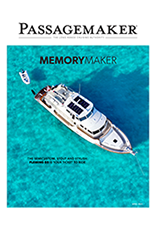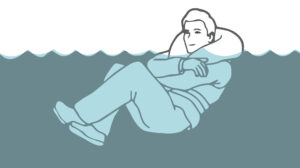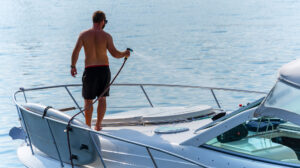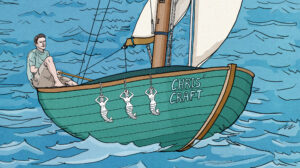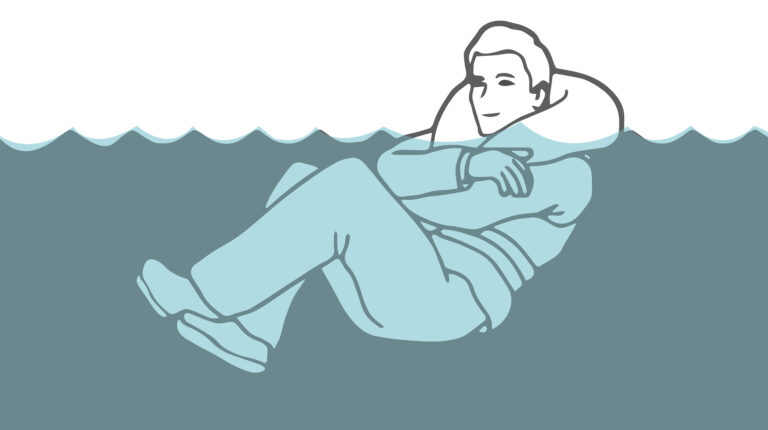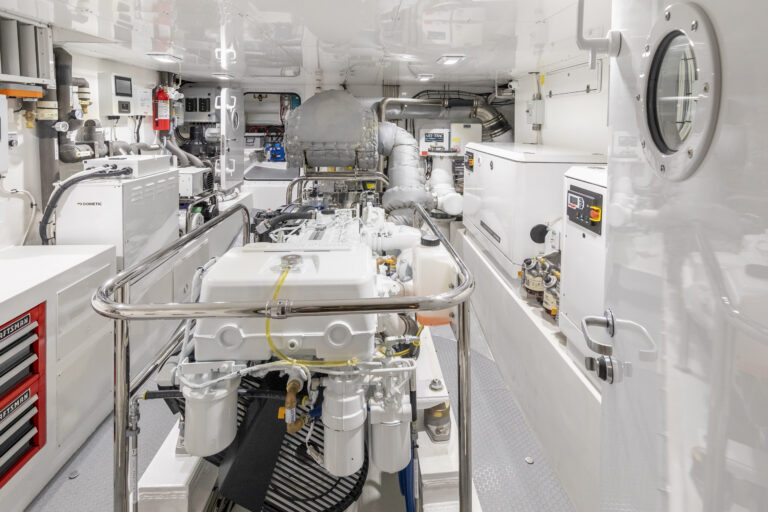
When chartering in Maine, it’s important to be able to get good advice from the charter boat owner or charter company on selecting the right boat for your experience level, your crew, and your cruising plans. The charter company also should be able to help you with developing an itinerary. In our charter business (www.bucksharbor.com), when we get an “entry level” charter client, we design a cruise plan with easier harbor entrances, transit times and courses that are a bit less demanding, and destinations with guest moorings.
We’ve been known to suggest a week of coastal navigation classes at the nearby WoodenBoat School (www.woodenboat.com), which offers unique and marvelous training programs. Then, we’ll develop a mutually agreed upon charter itinerary for the week after the class. Our charterers always end up thanking us in the end.
The next thing you want to look for is personal service. This starts with “concierge” service in terms of arranging for airport pickup, provisioning, and other special requests. Your charter company should be eager to make mooring or slip reservations for you, dinner suggestions and reservations, perhaps lend you a car so you can provision in town, find the right size child’s life jacket, put extra quilts or pillows aboard, help carry your gear to the boat, locate a rental bicycle or kayak, and even provide you with a list of beaches that welcome dogs.
You should expect an absolutely clean—I mean really clean—well-serviced and well-found boat. Other basics include full fuel, water, and LP gas tanks; spare LP gas; freshly laundered sheets and towels (and plenty of them); clean decks; no mud on the anchor chain; empty waste containers; a full supply of toilet paper and paper towels; no salt on the windshields or flybridge plexiglass; a working outboard and spare shear pins; and a full complement of safety gear, screens, and onboard tools and spares.
There should be a comprehensive operations manual, specific to your boat, on board. You should expect fairness and flexibility in administering the provisions of the charter contract, and you should expect an immediate response and support for any problem you encounter during your charter.
When you board the boat, you should be briefed by someone who knows both the boat and the waters—not a dock boy. (Yes, I had that experience while chartering from one of the largest charter companies in the Caribbean). The charter briefing should take place at a time when the entire crew can participate—certainly not during the tumult of provisioning and stowage. The briefing should cover everything from starting the engines to lighting the stove, from operating the heads and showers to making an emergency VHF call.
This is the time to go over your cruise plan with the charter briefer, to obtain local knowledge and recommendations, to learn about that special anchorage and what time to arrive to get the premium spot. It is a time to learn local tactics when it comes to clearing a pot warp from your prop, what to do in fog, and how much scope you need in which anchorage. It is a time to find out where to get the best lobster roll.
The charter briefing is the all-important key to a successful charter on the Maine coast. The old sailors’ saying is, “Different ships, different long splices.” And that is true. While there are common features on many power yachts and general rules when it comes to managing marine battery banks, each boat has its own quirks. A good charter briefing on a Grand Banks 36, for example, should take a minimum of 90 minutes and should cover the following:
• Operations manual and stowage plan
• Cruise plan and best destinations
• Electrical system and panel operation
• Battery management
• Shorepower system operation
• Fuel system
• Bilge pumps and dewatering
• Generator start and stop
• Heads, showers, and waste systems
• Navigation equipment
• Galley stove, LP gas, and alarms
• Refrigerator and freezer
• Engine start and stop checklist
• Engine, fire, and flooding alarms
• Engine operating gauge readings
• Controls
• Cruise settings and fuel consumption
• Key items in onboard inventory
• Anchoring and windlass operation
• Tactics for cruising in Maine waters
• Daily maintenance tasks
• Dinghy and outboard
• Safety briefing
• Question period
You should expect a thorough briefing on these topics and insist on further explanation of anything that is left out or is unclear.
I always make it a point to have everyone—I repeat, everyone, from cook to captain—make a VHF radio call and learn what to say in an emergency. I also insist that the captain and at least one other adult actually start, check, and stop the engine(s). And, finally, I always offer to leave the dock with captain and crew aboard and have them shoot some landings to give them a feel for the boat, her controls, and how to handle lines. This is a great confidence builder (for the crew and for me), and I have been given credit for saving several marriages.—Jerry Kirschenbaum
CHARTER BOAT EQUIPMENT
Following is a list of basic equipment you should expect to find aboard a well-found cruising motoryacht that is in charter service:
• Diesel engine(s)
• GPS/chart plotter (not handheld) with up-to-date charts
• VHF radio
• Magnetic compass, swung and corrected with posted compass card
• Depth finder
• Two anchors with chain rode; a windlass (hand or motor) is recommended
• Chronometer
• Radar if possible, but secondary to GPS/chart plotter
• Ship’s papers onboard
• Full set of paper charts and associated guides and tide tables
• Emergency tiller
• Full complement of USCG safety equipment, including life jackets, fire extinguishers, and flares
• Dinghy and outboard
• Operating high-capacity bilge pump
• Tools
• Key spares
• Functioning water pump
• Complete operating manual and instruction books for all equipment
• Quality, high-amp-hour marine starting and house batteries, fully charged
—Jerry Kirschenbaum
DOCKAGE, SLIPS, MOORINGS & ANCHORAGES IN COASTAL MAINE
Southern Maine and Casco Bay are filled with traditional marinas offering a full range of slips and amenities. You can find them in A Cruising Guide to the Maine Coast by Hank & Jan Taft and Curtis Rindlaub (www.coastguides.com) or at www.marinas.com.
As you head further east to Penobscot Bay and the Downeast region, marinas with dockside slips become fewer and farther between. The increasing tide range makes installation and maintenance of such slips much more expensive. Also, the amount of actual working waterfront is shrinking. The high value of waterfront homes and the decline of waterfront business (such as canneries and larger fishing fleets) have had a severe effect on the available water frontage.
More times than not, you will have to find a rental mooring. These are readily available in the larger and more popular harbors. Alternatively, you will have to think about using your anchor. The latest prevailing rate for rental moorings is approximately $30 to $35 per night; usually, this fee includes shoreside facilities, if they exist.
In July and August, it pays to make reservations for dockside slips, as well as rental moorings. If you are clear on your schedule, your charter company can make reservations for you, or you can do it yourself via VHF radio or cell phone. Remember: if you make a reservation but will be unable to reach your destination, call ahead and cancel.
Do not enter a harbor and just pick up a vacant mooring. You have no idea of how heavy that mooring is or when it was last inspected—not to mention that you run the risk of having the owner return in the middle of the night and be less than kind in rousing you from your warm berth.
Finally, if you are coming alongside a dock, remember to have all four of your lines made up and ready—particularly your midship spring line. That is the most important line in docking, since it controls your forward motion. There will not always be a shoreside dock boy ready to handle your lines. Any charter briefer should be more than happy to take you out and shoot a few landings with you, or run some practice approaches on a mooring before you depart on your cruise.
When it comes to anchoring in Maine, if you have a choice, plan to arrive in a harbor at low tide. Hidden ledges will reveal themselves, and you will have a rising tide to help you extract yourself from any grounding.
It’s wise to evaluate every anchorage based upon Maine’s high tidal range. For example, if you arrive at low tide and read a depth of 12 feet in the anchorage, a six-times scope will give you a scope of 72 feet. Given a 12-foot high tide, that scope will shrink to only 60 feet and may be inadequate. The reverse becomes important if you put out too much scope at high tide and watch your swing room increase, bringing you close to hazards such as ledges, lobster buoys, or other boats. Always check your anchoring area for any buoys that may drift under your stern on different tides and foul your rudders or props.
Most anchorages in Maine have mud bottoms. Plow, Bruce, or Danforth anchors will serve you well. If you are concerned about fouling an underwater ledge, place an anchor buoy on the anchor itself.
Make certain that you thoroughly understand your onboard anchoring system (including the second emergency anchor). This should be a key part of your charter-preparation briefing. Plan on anchoring quite often, since always counting on a shoreside slip or rental mooring may keep you from enjoying some of Maine’s wonderful remote destinations.—Jerry Kirschenbaum
THE ECONOMICS OF CHARTERING IN MAINE
At the time of this writing (early 2011), you could bareboat-charter a typical Grand Banks 36 trawler yacht, sleeping four to six people, for between $4,000 and $4,500 for seven nights. The charter fee usually includes everything except the cost of fuel (about $250 for the week) and a minor propane charge of $20. That comes out to a high-season cost of approximately $135 per person per day. (You cannot rent a medium-quality motel room for that amount.)
A GB 32 sleeping two adults and a child or two on the drop table in the main cabin can be had for about $2,850 to $3,200 for seven nights.
Most charter companies offer a pre-charter “sleep aboard” if your travel plans bring you to the charter base the night before your charter. A flat fee of approximately $150 takes care of the sleep aboard.
The difference in fees for the so-called off season (usually before Memorial Day and after Labor Day) is about a 10 percent discount. Multi-week charters also call for a discount that varies with each charter company or owner.
Should you need a licensed captain for your charter, the fee averages $250 to $300 per day, plus meals.—Jerry Kirschenbaum
CRUISING GUIDES, BOOKS, PERIODICALS, CHARTS & WEBSITES FOR A MAINE CHARTER
Following is a list of resources that you may find helpful in planning a charter and while cruising in Maine.
Cruising Guides
• A Cruising Guide to the Maine Coastby Hank & Jan Taft and Curtis Rindlaub (Diamond Pass Publishing Inc., Fifth Edition); www.coastguides.com—This is the bible for cruising in Maine. No contest. You can tell by the hefty page count (466 pages) and weight that this guide is the one book you have to have on board for a successful charter. The guide contains detailed information on virtually every harbor, town, cove, and anchorage in the state of Maine. The book, now in its 20th year, is published by several generations of a Maine sailing family. Any charter boat in Maine should have this guide on its navigation station bookshelf; if it doesn’t, you should wonder if you have booked the right boat.
• A Visual Cruising Guide to the Maine Coastby James Bildner (International Marine/Ragged Mountain Press, 2006)—Another absolutely invaluable book for cruising the Maine coast. The book consists of 180 full-color low-altitude aerial photos, each matched to a specific chart, showing harbors, approaches, and passages. Author James Bildner is a sailor and helicopter pilot living in Northhaven, Maine; he added chart segments and proper course lines to each of his photos and keyed these to the corresponding nautical chart. This outstanding book is, as we say in Maine, “some wicked.”
• The Cruising Guide to the New England Coast by Roger Duncan (W.W. Norton Co., 12th Edition)—This is another classic, first published in 1937 and continuously updated by this well-known and highly experienced cruising sailor.
Charts & Navigation
• Your charter boat should not only have a GPS/chart plotter loaded with current software, but also a complete set of paper charts for the coast of Maine. NOAA charts are available up and down the coastline. There are also valuable (and waterproof) charts for the coast of Maine available from Waterproof Charts Inc. (www.waterproofcharts.com); these are also available at most marine chandleries. These charts have a variety of features that are different from the NOAA charts (for instance, their Charts 103, 104, and 105 are all you need for cruising the Penobscot Bay and Mt. Desert Region; Chart 103 is the only chart showing the full length of Eggemoggin Reach).
• If you enjoy obtaining your own charts and preplanning your trip with your own route markings, dead-reckoning points, waypoints, and destinations, you can either use governmental (NOAA) charts, obtainable from your local supplier, or use one of the excellent ChartKits available from Maptech (www.richardsonscharts.com). Again, you may be able to obtain these charts from your charter company, local marine store, or web sources.
• You should specifically ask your charter company for a list of charts and publications that are in the onboard inventory. A well-found charter boat should have up-to-date tide and current tables or a current almanac (like Eldridge Tide and Pilot Book) on board.
• U.S. Government Pilots and Light Lists are rarely found on charter boats, but they can be quite useful in setting up your piloting and waypoints. The relevant government publications are Tidal Current Tables, Atlantic Coast; U.S. Coast Pilot (Eastport to Cape Cod); and Light & Buoy List (CG-158).
• Another useful publication is The International Marine Light List & Waypoint Guide: Maine to Texas by John & Leslie Kettlewell, available from www.amazon.com. This book saves you the trouble of hand-plotting key GPS points for input into your GPS system.
Websites
• www.mainecoastguide.com (Maine Coast Internet Guide)—This site has easily accessible current almanac and tide tables and many other interactive features.
• www.maine.gov/dmr/aerialphotos—Featuring detailed aerial photos of each harbor and cove, this site is maintained by the Maine Department of Marine Resources and is quite user friendly; it shows actual satellite photography of any harbor you are about to enter.
• www.marinas.com—This is a terrific site that features detailed online aerial photography of harbors and marina facilities. The charts and photos clearly show entrances and surrounding landmarks.
• www.great-maine-vacations.com—Information on Maine vacations and a calendar of events.
• www.anglerweb.com—Information about fishing locations.
Maine Periodicals And Coastal Newspapers
• Maine Coastal News
• Fisherman’s Voice
• Points East
• The Working Waterfront
• Downeast Magazine
• WoodenBoat Magazine
• Maine Boats, Homes & Harbors Magazine
Many of these publications have corresponding websites and a significant online presence, particularly when it comes to detailed information on tides and weather, as well as a current calendar of events.
Books For A Maine Charter Cruise
• Time of Wonder,Blueberries for Sal, and One Morning in Maine—all essential and beloved Maine children’s books written by the late Robert McCloskey, longtime resident and sailor of the Penobscot Bay region
• The Story of the Sea Glass by Ann W. Dodd
• Sea Shells in my Pocket by Judith Hansen
• A Unit of Water, A Unit of Time by Douglas Whynott
• Gift from the Sea by Anna Morrow Lindbergh
• Seafood: Down East Recipes by Marjorie Standish
• Chowders, Soups & Stews byMarjorie Standish
• Cooking Downeast byMarjorie Standish
• The Mapmaker’s Kitchen by Jane Crosen
• All Maine Seafood Cookbook (2nd Edition) byLoana Shibles and Annie Rogers
